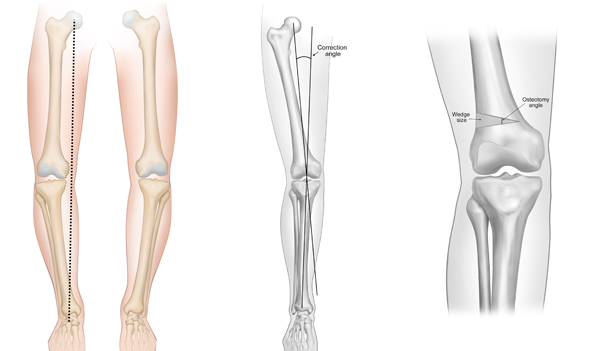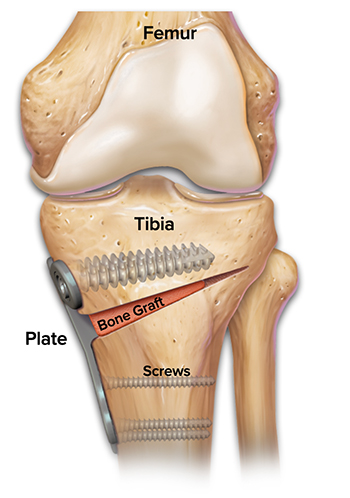Knee
- Knee Malalignment
- Knee Malalignment Non-Surgical Treatment
- Knee Malalignment Surgical Treatment
- Recovering from Knee Osteotomy
- Patient Resources
Knee Malalignment
Anatomy of the Knee and Leg Alignment
The knee joint is formed by three bones:
Femur – the thigh bone
Tibia – the shin bone
Patella – the kneecap
The long axis of the leg is an imaginary line that runs from the center of the hip joint down to the center of the ankle joint. This axis is important for defining the orientation and alignment of the leg bones.
Maintaining proper alignment along the long axis is crucial for normal biomechanics and efficient movement. Deviations from this alignment can alter the distribution of forces across the knee joint, potentially leading to abnormal stress, instability, or injury.
What is knee malalignment?
Knee Malalignment
Knee malalignment occurs when the knee joint deviates from its normal or neutral position along the long axis of the leg. There are two main types:
Genu valgum (knock knees): The knees angle inward and touch each other when the legs are straightened.
Genu varus (bow-legged): The knees curve outward, creating a gap between the lower legs when the feet are together.
Both genu varus and genu valgum can affect the biomechanics of the knee joint, increasing the risk of injury and potentially contributing to long-term conditions such as osteoarthritis.
What causes knee malalignment?
Knee malalignment can be caused by genetic factors, developmental issues, nutritional deficiencies, and certain medical conditions, such as ligament laxity, muscle imbalance, and Rickets disease.
What are the symptoms of knee malalignment?
- Knee Alignment: When standing with the feet together, there may be a visible bowing of the knees (varus alignment) or knock-knees (valgus alignment) while the ankles touch or nearly touch.
- Gait Abnormalities: Individuals with knee malalignment may exhibit altered gait mechanics during activities such as walking or running.
- Pain and Discomfort: Due to abnormal stress on the structures supporting the knee, varus alignment can potentially lead to pain or discomfort around the medial (inside) aspect of the knee whereas valgus alignment can lead to pain or discomfort on the lateral (outside) aspect of the knee.
- Instability: The altered alignment may contribute to feelings of instability, especially during weight-bearing activities.
How do you diagnose knee malalignment?
Diagnosis of Knee Malalignment
A successful diagnosis of knee malalignment requires a combination of:
A detailed patient history
A comprehensive physical examination
X-rays, and in some cases, MRI or CT scans
Knee surgeon Dr. Bryan Penalosa and his team perform a thorough evaluation, including:
Assessment of gait mechanics
Measurement of range of motion
Evaluation of knee stability
Identification of points of tenderness
A long-limb X-ray is obtained to measure the degree of malalignment. An MRI may be ordered to assess for associated meniscal or cartilage injuries, which can occur due to additional strain on the medial knee compartment (in varus alignment) or lateral knee compartment (in valgus alignment). In some cases, a CT scan may be necessary to further evaluate the bony anatomy and accurately determine the severity of malalignment.
Knee Malalignment Non-Surgical Treatment
In many cases, conservative treatment is the first line of treatment for knee malalignment. For patients who are candidates for non-operative treatment, the focus of care will be on reducing pain, swelling, and inflammation, while also improving the overall stability and function of the knee.
Rest and Activity Modification
During flare-ups of pain, it is essential to rest the knee and avoid activities that worsen the pain.
Oral Anti-Inflammatories, Ice, and Compression
Oral anti-inflammatory and pain-relieving medications, such as Meloxicam, Naproxen, Advil, or Ibuprofen, may help to manage the pain and reduce inflammation of the knee. Applying ice packs and compression to the knee can also help reduce swelling and inflammation. Remember to use a cloth or towel between the ice pack and your skin to avoid frostbite.
Physical Therapy
A structured physical therapy program can be beneficial for strengthening the muscles around the knee and improving overall joint stability. A physical therapist can guide you through exercises that focus on the quadriceps, hamstrings, and calf muscles to provide this additional support to the knee. Additionally, proprioceptive training can enhance knee stability. Proprioception is the body’s ability to sense joint position and movement, and improved proprioception can help with knee stability and control during activities. It is important to complete any home exercises that your physical therapist provides to you in order to optimize your recovery.
Unloader Brace
An unloader brace is a specific type of knee brace designed to offload the overloaded compartment of the knee. In cases of varus alignment, a medial unloader brace is ordered to alleviate some of the stress on the medial (inside) compartment of the knee. In cases of valgus alignment, a lateral unloader brace is ordered to decrease the load of the lateral compartment. The unloader brace offers mechanical support, stabilization, and symptomatic relief while also protecting the knee compartment and promoting overall joint health and preservation.
Intra-Articular Knee Injections
The goal of an intra-articular injection is to manage pain and inflammation of the knee. Therefore, injections may be used as a short-term measure to manage these symptoms during an episode of more intense pain. However, it’s crucial to understand that an intra-articular injection will not heal cartilage damage or malalignment. Additionally, receiving an intra-articular injection to the knee will delay any surgical intervention for at least 3 months following the administration of the injection.
Knee Malalignment Surgical Treatment
Surgical Treatment for Knee Malalignment
For patients with knee malalignment who have not responded to conservative treatment, surgical intervention may be a reasonable option. Knee surgeon Dr. Bryan Penalosa may discuss performing an osteotomy, a surgical procedure in which a bone is carefully cut and reshaped to correct alignment.
The goals of an osteotomy are to:
Correct bone deformities
Redistribute weight-bearing forces
Preserve overall joint health
Improve joint function
The type of osteotomy performed depends on the specific type of malalignment (varus or valgus). In addition to the osteotomy, Dr. Penalosa may perform a diagnostic knee arthroscopy to identify and treat any concomitant meniscal or cartilage injuries.
Below are the most common types of osteotomies used to correct varus and valgus knee malalignment.
High Tibial Osteotomy (HTO)
High Tibial Osteotomy (HTO)
A high tibial osteotomy involves cutting and repositioning the upper part of the tibia (shinbone) to correct knee malalignment, commonly in cases such as osteoarthritis or genu varum (bow-leggedness). This procedure is often performed to shift the weight-bearing load away from the medial compartment of the knee, reducing pain and potentially slowing the progression of arthritis.
Prior to surgery, Dr. Bryan Penalosa calculates the exact degree of correction and the location of the osteotomy using X-ray imaging. During the procedure:
A controlled cut (osteotomy) is made in the upper tibia.
The tibia is repositioned to correct the malalignment.
The osteotomy site is filled with bone chips to prevent collapse.
The osteotomy is stabilized using a plate and screws.
Following surgery, patients are strictly non-weight bearing for 6–8 weeks to allow proper healing.
Distal Femoral Osteotomy (DFO)
Distal Femoral Osteotomy (DFO)
A distal femoral osteotomy involves cutting and repositioning the lower part of the femur (thigh bone) to correct knee malalignment, commonly in cases such as osteoarthritis or genu valgum (knock-knees). This procedure is typically performed to shift the weight-bearing load away from the lateral compartment of the knee, reducing pain and potentially slowing the progression of arthritis.
Before surgery, Dr. Bryan Penalosa calculates the exact degree of correction and the location of the osteotomy using X-ray imaging. During the procedure:
A controlled cut (osteotomy) is made in the lower femur.
The femur is repositioned to correct the malalignment.
The osteotomy site is filled with bone chips to prevent collapse.
The osteotomy is stabilized using a plate and screws.
After surgery, patients are strictly non-weight bearing for 6–8 weeks to ensure proper healing.
Recovering from Knee Osteotomy
Recovery After Knee Osteotomy
Your recovery from an osteotomy begins the first day after surgery. Early physical therapy is critical for:
Restoring range of motion
Reactivating the quadriceps muscles
Subsequent phases of post-operative rehabilitation are carefully planned to enhance recovery and prevent future injury. Immediately following surgery, patients are non-weight bearing for 6–8 weeks, as the osteotomy site must heal before any weight is placed on the operative leg. Strict adherence to the non-weight-bearing protocol is essential for optimal outcomes.
Overall recovery from an osteotomy typically takes 6–9 months, which includes:
Restoring range of motion
Strengthening muscles around the knee
Re-establishing balance and coordination
Returning to full function
Even after rehabilitation, ongoing injury prevention strategies remain crucial to minimize the risk of future knee injuries.
What are the complications of untreated knee malalignment?
Potential Complications of Untreated Knee Malalignment
If knee malalignment is left untreated, it can lead to various complications affecting both the structure and function of the knee joint. Some of the potential complications include:
Osteoarthritis
Chronic malalignment causes abnormal wear and tear on the joint surfaces. Over time, this increased stress on the articular cartilage can contribute to the development of osteoarthritis, a degenerative condition characterized by pain, inflammation, and reduced joint mobility.Meniscal Tears
Malalignment can cause uneven force distribution across the knee, increasing the risk of meniscal injuries. The menisci act as shock absorbers in the knee, and abnormal stress can make them more prone to tearing.Ligament Injuries
Knee instability caused by malalignment makes the joint more susceptible to ligament injuries, including anterior cruciate ligament (ACL) tears, especially in certain types of malalignment.Cartilage Damage
Misalignment can concentrate pressure on specific areas of the joint, leading to focal cartilage damage. These lesions can result in pain, swelling, and further joint deterioration if left unaddressed.Gait Abnormalities
Individuals with untreated malalignment often develop compensatory walking patterns to reduce discomfort. These altered mechanics can increase stress on other joints, potentially causing pain or dysfunction in the hips, lower back, or other lower extremity joints.Functional Limitations
Chronic pain and instability can reduce mobility, limiting the ability to perform daily activities, sports, or recreational activities. Over time, these limitations can significantly reduce overall quality of life.
Patient Resources
Orthopedic surgeon Dr. Bryan Penalosa and his team are dedicated to providing an industry-leading patient experience—one that is smooth, efficient, and convenient. Our team has compiled a comprehensive set of orthopedic patient resources to assist you with insurance information, patient forms, and much more.
Explore the patient resources below to learn more.
- Preparing for Surgery
- Traveling for Surgery
- Pre-Operative Clearance
- Peri-Operative Nutrition
- Post-Operative Instructions
- Post-Operative Physical Therapy
- Post-Operative Medications
- Durable Medical Equipment
- Billing & Insurance
- Patient Portal
- Medical Records
- Patient IQ
- Clinical Case and Imaging Review
- Ongoing Clinical Trials
- Sports Performance Center
